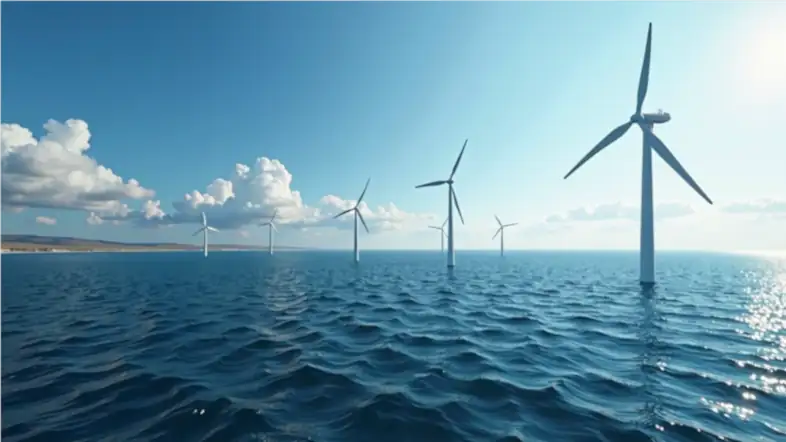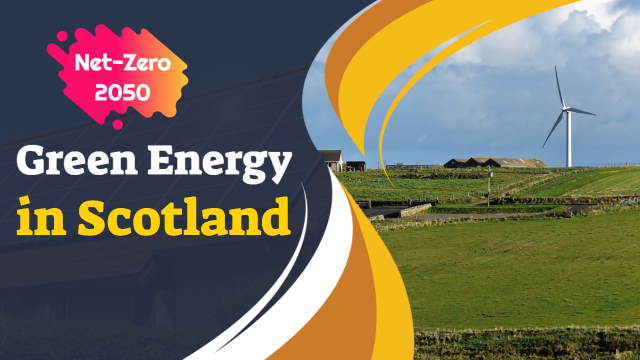Renewable green energy in Scotland has advanced rapidly since 2010 when we first posted our article on this subject. Scottish renewables benefit from the high winds of the nation. There is also an ability to spread investment costs across the whole of the UK consumer base.
Scotland stands at the forefront of the green energy revolution, leading the United Kingdom in investment and innovation. With its abundant natural resources, forward-thinking policies, and dedicated workforce, Scotland is transforming its energy landscape, paving the way for a sustainable and prosperous future. Whether you're an investor, business owner, or simply passionate about renewable energy, Scotland offers unparalleled opportunities to be part of this dynamic sector.
The Scottish Commitment to Renewable Energy
Scotland's commitment to renewable energy is unwavering. The country's strategic initiatives and supportive policies have created an environment conducive to growth and innovation in the green energy sector. Here's how Scotland is making a significant impact:
Ambitious Renewable Targets
Scotland has set some of the most ambitious renewable energy targets in the UK, aiming to achieve net-zero carbon emissions by 2045. This commitment drives continuous investment in renewable technologies and infrastructure, ensuring sustained growth and development.
Supportive Government Policies
The Scottish Government has implemented a range of policies to support the green energy sector. These include grants, tax incentives, and streamlined planning processes, all designed to attract investment and facilitate the growth of renewable energy projects.
Collaboration with Industry Leaders
Scotland collaborates closely with leading energy companies, research institutions, and community organizations. This collaborative approach fosters innovation, drives technological advancements, and ensures that renewable energy projects are both economically viable and environmentally sustainable.

Key Sectors Driving Green Energy in Scotland
Scotland's green energy landscape is diverse, encompassing various sectors that contribute to the nation's renewable energy capacity. These key sectors include:
Wind Energy
Scotland is renowned for its wind energy potential, boasting some of the highest wind speeds in Europe. Both onshore and offshore wind farms are integral to Scotland's renewable energy portfolio, providing clean and reliable power to millions of homes.
Onshore Wind: Scotland's rugged terrain and open landscapes make it ideal for onshore wind farms. These installations harness the power of the wind to generate electricity, contributing significantly to the national grid.
Offshore Wind: Leveraging its extensive coastline, Scotland is a leader in offshore wind energy. Offshore wind farms benefit from stronger and more consistent winds, offering substantial energy output and economic benefits.
Hydro Power
Hydropower has been a cornerstone of Scotland's renewable energy for decades. Utilizing the power of flowing water, hydroelectric schemes generate a significant portion of the country's renewable energy.
Run-of-the-River: This method harnesses the natural flow of rivers, generating electricity without the need for large dams. It's an environmentally friendly approach that minimizes impact on local ecosystems.
Pumped Storage: Pumped storage facilities play a crucial role in energy storage, balancing supply and demand by storing excess energy generated during peak production times for use during periods of high demand.
Solar Energy
While Scotland is often associated with wind and hydro power, solar energy is also making significant strides. Advances in solar technology and decreasing costs have made solar installations more accessible and economically viable.
Residential Solar Panels: Increasingly, homes across Scotland are adopting solar panels, reducing energy bills and the carbon footprint of households.
Solar Farms: Larger solar installations contribute to the national grid, providing clean energy on a substantial scale and supporting Scotland's renewable energy goals.
Bioenergy
Bioenergy harnesses organic materials, such as agricultural waste and forestry residues, to produce heat, electricity, and biofuels. It's a versatile and sustainable energy source that complements other renewables.
Biomass Power Plants: These facilities convert organic materials into electricity, providing a reliable and renewable energy source that supports the grid during periods of low renewable generation.
Biofuels: Sustainable biofuels are essential for reducing emissions in the transportation sector, offering a cleaner alternative to fossil fuels.
Economic and Industrial Growth through Green Energy
The transition to green energy in Scotland is not only an environmental imperative but also a significant driver of economic and industrial growth. Here's how the green energy sector is fueling Scotland's economy:
Job Creation
The green energy sector is a major employer in Scotland, offering a wide range of job opportunities across various skill levels. From engineering and construction to research and development, the sector supports thousands of jobs and continues to grow.
Investment Opportunities
Scotland's leadership in green energy presents attractive investment opportunities. Both domestic and international investors are drawn to Scotland's robust renewable energy projects, supported by favorable policies and a stable economic environment.
Technological Innovation
Scotland is a hub for technological innovation in the renewable energy sector. Investment in research and development has led to advancements in energy storage, grid management, and renewable technologies, ensuring Scotland remains at the cutting edge of the green energy revolution.
Infrastructure Development
The growth of the green energy sector drives the development of essential infrastructure, including power grids, transmission lines, and energy storage systems. This infrastructure not only supports renewable energy generation but also enhances overall energy security and resilience.
Scotland's Renewable Energy Projects: Success Stories
Scotland is home to numerous successful renewable energy projects that showcase its leadership and commitment to sustainability. Here are a few notable examples:
The European Offshore Wind Deployment Centre
Located in Aberdeen, the European Offshore Wind Deployment Centre is a pioneering project that supports the development and testing of next-generation offshore wind technologies. It serves as a collaborative platform for industry leaders, accelerating the deployment of innovative solutions in the offshore wind sector.
The Moray East Offshore Wind Farm
The Moray East Offshore Wind Farm is one of Scotland's largest wind energy projects, generating enough electricity to power over 200,000 homes. This project exemplifies Scotland's capability to deliver large-scale renewable energy solutions, contributing significantly to the national grid.
The Galloway Hydro Initiative
The Galloway Hydro Initiative is a state-of-the-art hydropower project that harnesses the power of local rivers to generate clean energy. This initiative supports the local economy, creates jobs, and provides a reliable source of renewable energy to the region.
The Sgurr energy storage project
The Sgurr energy storage project utilizes advanced battery technology to store excess renewable energy. This project enhances grid stability, ensures a consistent power supply, and demonstrates Scotland's commitment to integrating renewable energy into the national grid efficiently.
Benefits of Investing in Scotland's Green Energy Sector
Investing in Scotland's green energy sector offers numerous advantages, making it an attractive destination for investors and businesses alike. Here are some key benefits:
Stable Investment Environment
Scotland provides a stable and supportive investment environment, with clear policies, robust regulatory frameworks, and a commitment to renewable energy. This stability reduces investment risk and fosters long-term growth.
Access to Skilled Workforce
Scotland boasts a highly skilled and educated workforce, with expertise in engineering, research, and renewable energy technologies. This talent pool supports the development and operation of renewable energy projects, ensuring their success.
Strategic Location
Scotland's strategic location offers proximity to major European markets, facilitating the export of renewable energy and related technologies. Its extensive coastline also provides ideal conditions for offshore renewable energy projects.
Environmental Stewardship
Investing in Scotland's green energy sector aligns with global sustainability goals and showcases a commitment to environmental stewardship. This alignment enhances corporate reputation and meets the growing demand for sustainable business practices.
How to Get Involved in Scotland's Green Energy Future
Whether you're an investor, entrepreneur, or community member, there are multiple ways to engage with Scotland's green energy sector. Here are some steps to get involved:
Explore Investment Opportunities
Scotland offers a range of investment opportunities in renewable energy projects. Research available projects, attend industry conferences, and connect with local energy companies to identify potential investments that align with your interests and goals.
Partner with Local Businesses
Collaborating with local energy businesses can provide valuable insights and opportunities for joint ventures. Partnerships can enhance project development, share expertise, and accelerate the deployment of innovative renewable energy solutions.
Support Community Initiatives
Community-based renewable energy projects play a vital role in Scotland's green energy landscape. Support local initiatives by investing in community energy schemes, participating in cooperative projects, or volunteering your time and expertise.
Stay Informed and Educate Others
Stay informed about the latest developments in Scotland's renewable energy sector by following industry news, attending seminars, and engaging with professional networks. Educate others about the benefits of green energy and advocate for sustainable practices in your community.
The Future of Green Energy in Scotland
Scotland's green energy sector is poised for continued growth and innovation. As global demand for renewable energy increases, Scotland is well-positioned to expand its capabilities and reinforce its leadership in the UK and beyond. The future looks bright, with ongoing investments, technological advancements, and a steadfast commitment to sustainability driving the sector forward.
Emerging Technologies
Advancements in energy storage, smart grids, and renewable energy technologies will further enhance Scotland's renewable energy capacity. Emerging technologies offer new opportunities for efficiency, reliability, and scalability, ensuring that Scotland remains at the cutting edge of the green energy revolution.
Expansion of Renewable Projects
The pipeline of renewable energy projects in Scotland continues to grow, with new wind farms, hydroelectric schemes, solar installations, and bioenergy projects in development. This expansion will increase renewable energy production, reduce carbon emissions, and support economic growth.
Enhanced Energy Resilience
Investments in energy storage and grid management technologies will enhance Scotland's energy resilience, ensuring a stable and reliable power supply even during periods of high demand or low renewable generation. This resilience is crucial for maintaining energy security and supporting continued economic development.
Global Leadership
Scotland's success in the green energy sector positions it as a global leader in renewable energy. By sharing its expertise, collaborating with international partners, and exporting renewable technologies, Scotland can influence global energy policies and contribute to worldwide sustainability efforts.
Join Scotland's Green Energy Movement
Scotland's leadership in green energy is more than just a regional advantage—it's a global statement of commitment to sustainability and innovation. By investing in Scotland's renewable energy sector, partnering with local businesses, or supporting community initiatives, you can be part of a movement that is shaping the future of energy.
Contact Us Today
Are you ready to explore the opportunities in Scotland's green energy sector? Our team of experts is here to guide you through the investment process, connect you with local partners, and provide the support you need to succeed in the renewable energy market.
Get in touch with us today to learn more about how you can contribute to Scotland's green energy future.
Subscribe to Our Newsletter
Stay updated with the latest news, projects, and investment opportunities in Scotland's renewable energy sector. Subscribe to our newsletter and never miss an update!
Visit Our Office
Interested in discussing your renewable energy project in person? Schedule a visit to our office in Scotland and meet with our team of dedicated professionals.
Conclusion
Scotland's green energy sector is a beacon of innovation, sustainability, and economic growth. Leading the UK in investment, Scotland offers a fertile ground for renewable energy projects that not only benefit the environment but also drive substantial economic and industrial advancements. From wind and hydro power to solar and bioenergy, Scotland's diverse energy portfolio is a testament to its commitment to a sustainable future.
By investing in Scotland's green energy sector, you are not only supporting the transition to renewable energy but also contributing to the creation of jobs, technological advancements, and a resilient economy. Scotland's strategic location, skilled workforce, and robust infrastructure make it an ideal destination for those looking to make a meaningful impact in the renewable energy landscape.
Join Scotland's green energy movement today and be part of a future where clean, sustainable energy powers our lives and drives economic prosperity. Together, we can build a greener, more sustainable Scotland and set an example for the rest of the world to follow.
Original Article (Feb 27, 2011):
Green Energy in Scotland To Get Further Red Tape Slashed
Organizations with public buildings and businesses suitable for installing solar panels, and heat pumps, etc, will soon be able to go ahead and generate energy, without requiring planning permission
This follows measures under which the Scottish Government has already reduced the planning burden similarly for homeowners.
A Parliamentary Order within the Scottish Government will be put through, which will pave the way for an assortment of green technologies to be installed on non-domestic buildings, and they state that this will be in place from March 18.
The technologies assisted by this measure will include:
* Solar thermal panels;
* Solar photovoltaic panels;
* Pipework for ground source heat pumps;
* Pipework for water source heat pumps;
* Biomass boilers.
The Scottish Government’s Infrastructure Minister Keith Brown said:
“These changes will help cut red tape in the planning system and enable savings on energy bills. More use of microgeneration technologies such as solar panels can help Scots reduce their emissions and boost the development of a low carbon economy, which is key to Scotland's future success as a nation, creating new jobs in an emerging industry.”
The government press release points out that roof and wall space on large buildings is ideal for solar or photovoltaic panels to generate heat and electricity for use on-site. When there is a surplus excess electric power can be exported to the grid, or there may be other users respectively if a combined heat and power system is also provided.
Clearly, the emerging generation of lower capital cost photovoltaic cells (PVs) is the technology expected to be assisted most by this move. As Scotland is a northern country that experiences weaker sunshine than further south, uptake of PV technology will still be more likely to be more popular further south within the UK. However, the move is to be welcomed as another small step toward improved sustainability.
Also, with the recent further rise in the cost of oil due to the revolutionary turmoil, most recently in Libya, the cost benefits and payback period of PV technologies, are continually improving.
Heat pumps also provide an extremely energy-efficient way of converting the heat in the ground for space and hot water heating. These use the “flywheel” effect of the ground around and below our buildings which stays relatively warm even in cold weather, so the warmth can effectively be pulled from it, using less energy to do that than just “burn” the electrical energy for heating, as would have been done in the past.
The legislation is part of what the Scottish Government will have to do to achieve their renewable heat and electricity targets. More will also have to be done to incentivize the use of on-site renewable energy technologies if the government is to meet its targets.
[Published in 2011. Updated April 2020 and February 2025.]





